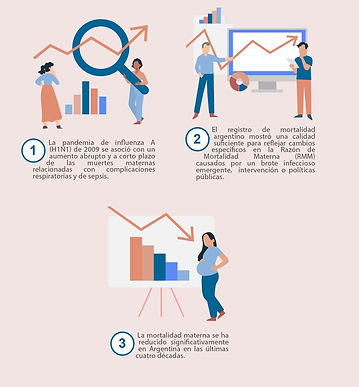Impact of pandemic viruses on maternal health in Argentina
In this collaborative study, led by Dr. Elard Koch, senior epidemiologist at the MELISA Institute (Chile) and conducted together with María Elena Critto (doctoral fellow) and a team of researchers affiliated with academic centers in Argentina, Peru and Chile, the a 38-year time series of Argentine vital records to assess the trend in the maternal mortality ratio (number of women who die year after year during pregnancy, childbirth and the puerperium for every 100,000 live births), due to specific causes before , during and after the global epidemic caused by the H1N1 influenza virus in 2009.
Unlike randomized experiments or clinical trials, in which researchers are in full control of the intervention, natural population experiments can use interrupted time series (STI) to capture the effect of a causal factor by assessing trends of underlying mortality, before and after the introduction of an exogenous event that affects an entire population. For this reason, this type of design is ideal for quantifying the effects of new public policies or natural disasters such as epidemics triggered by new viruses.

The study revealed that the 2009 H1N1 pandemic led to a short-term, abrupt increase in maternal deaths; It also showed that the Argentine mortality registry is of sufficient quality to reflect specific changes in the MMR; and that maternal mortality has been significantly reduced in the last four decades.


Between 1980 and 2017, the total MMR decreased by 58.6%. However, in 2009, there was a temporary peak in maternal deaths of 55 per 100,000 live births, clearly associated with the H1N1 pandemic.
In the period studied, there was a change in the main causes of maternal death, from direct obstetric causes to a pattern dominated by indirect causes. This change is known as the obstetric transition, associated with the aging of the population and better living conditions.


The 2009 AH1N1 pandemic generated an abrupt and short-term increase in maternal deaths related to respiratory complications and sepsis. In the graphs presented, we visualize the trend followed by maternal mortality and how it increased in 2009, globally and specifically by cause.
Finally, the study confirmed that Argentina currently has an uninterrupted registry of maternal deaths between 1980 and 2017, with sufficient quality to reflect changes in the MMR due to interventions or external events, such as emerging virus pandemics (in this study, influenza A virus H1N1). This is relevant for epidemiological surveillance of the ongoing SARS-CoV-2 outbreak or other future pandemics.







